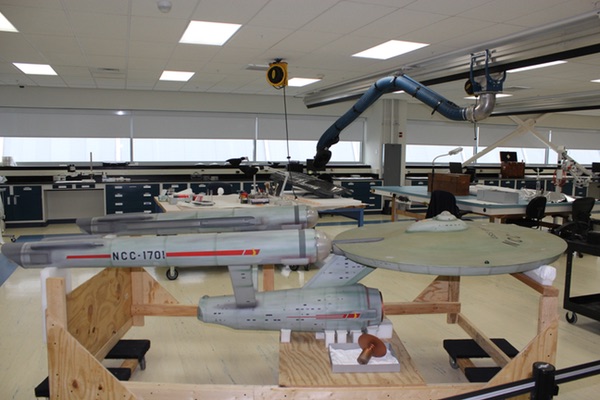Spacewalking through America’s Atticby Dwayne A. Day
|
| The artifacts that were displayed for the open house tended to be rather obscure. |
In the late 1990s, the visitor tours stopped as the museum began conducting a massive inventory of its artifacts and prepared to open its Steven F. Udvar-Hazy Center, a large museum near Dulles International Airport in Virginia, outside Washington, DC. The Udvar-Hazy Center, which opened in 2003, contains hundreds of airplanes and other objects, including missiles and spacecraft. The two most famous artifacts in its collection are the space shuttle Discovery and the Enola Gay. But the center also contains the museum’s restoration and storage facilities, and in 2014 the museum held its first annual open house to allow the public to go behind the scenes.
This past Saturday, for the second year in a row, the museum held an open house, and thousands of visitors got to see the large restoration hangar and other preservation labs and storage rooms. Although most of the artifacts on display were aircraft (for the simple reason that they are larger and more plentiful than space objects), a number of space-related artifacts were also displayed for the public.
Because space objects are rare and in high demand, much of the museum’s collection is on display at its own facilities or on loan to other museums around the world. The artifacts that were displayed for the open house tended to be rather obscure.
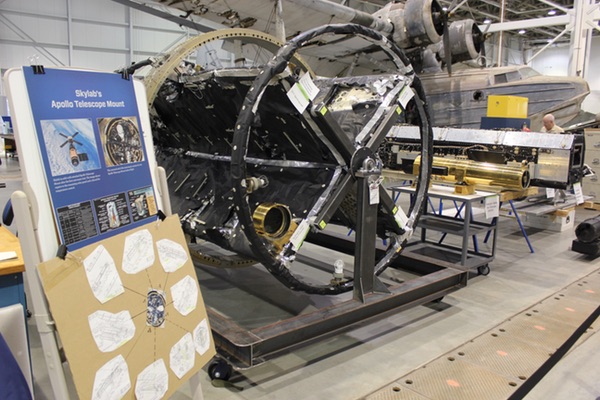 Skylab’s Apollo Telescope Mount. (credit: D. Day) |
One of the largest space artifacts on view was the Apollo Telescope Mount and several of its solar astronomy instruments from the backup Skylab Orbital Workshop. The backup workshop itself has been located at the main museum for decades, where visitors have been able to walk through it. The Telescope Mount armature was in storage for many years, but the eight instruments had been returned by NASA to the scientists who had developed them. Museum curator David DeVorkin has managed to collect five of the instruments and they are currently being restored and prepared for reinstallation in the mount. Eventually they will be displayed at the Udvar-Hazy Center.
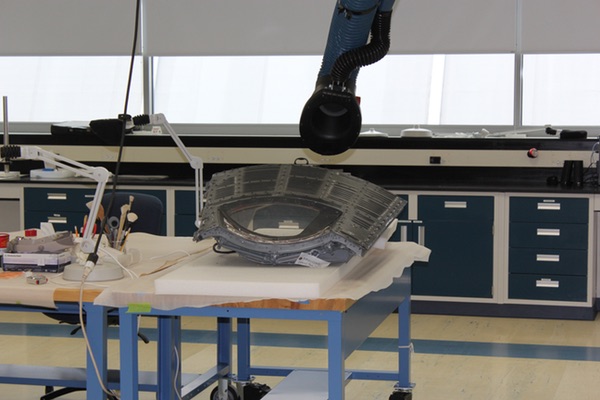 The Gemini 3A hatch undergoing restoration. (credit: D. Day) |
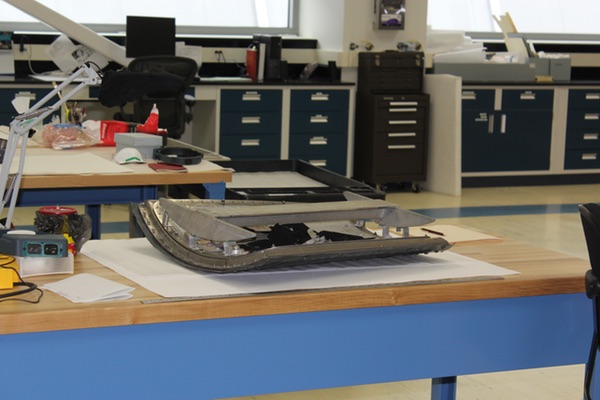 The Friendship 7 hatch undergoing restoration. (credit: D. Day) |
Some of the artifacts that were displayed are actually part of larger spacecraft. In the Emil Buehler Conservation Laboratory, technicians had set out two hatches. One was from John Glenn’s Friendship 7 spacecraft, currently on display in the main museum downtown. Another was a hatch from the Gemini 3A spacecraft, which is on display in the Udvar-Hazy’s James S. McDonnell Space Hangar. Gemini 3A is the only flight-qualified Gemini spacecraft that never flew into space. It was used by NASA as a ground test vehicle and later loaned to the Air Force for the Manned Orbiting Laboratory program. According to a technician, the hatch was painted multiple times and requires some restoration work.
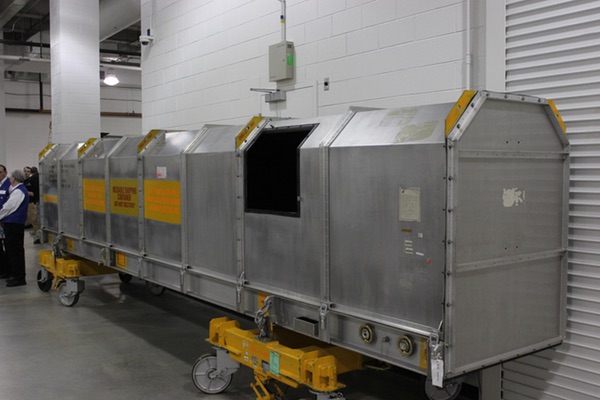 The crate for the Canadarm on display at the museum. (credit: D. Day) |
Some of the artifacts can be rather mundane, such as a container for the Canadarm. The Canadarm is on display in the nearby space hangar, but there is little public interest in the box that it came in. Nevertheless, if the museum curators ever decide to transport or store the arm, the specialized storage container that it came in could be useful. A similar crate for one of the Apollo Telescope Mount instruments was nearby and may ultimately be disposed of.
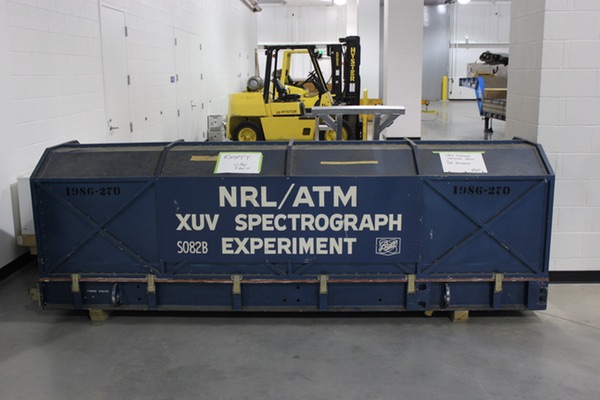 The crate for the Apollo Telescope Mount. (credit: D. Day) |
| Although the National Air and Space Museum is not dedicated to television history or memorabilia, Star Trek occupies a unique place in American culture. |
Museum conservation experts have to deal with many different materials, from various metals to wood to fabrics. Spacesuits present a particular challenge. They are made of many soft materials including fabrics, rubber, and plastics, and have already deteriorated. The museum keeps them in cold storage to limit further deterioration, and occasionally retrieves them for restoration work. They had on display some Apollo 9 artifacts labeled “biobelts,” which were used for attaching instruments to the astronauts’ bodies.
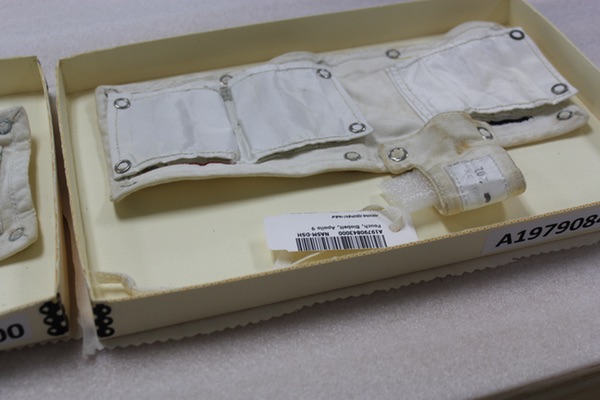 An Apollo spacesuit “biobelt”. (credit: D. Day) |
The most famous object on display at the open house even made it onto little buttons that museum staff gave out at the door. This was the original model of the starship USS Enterprise from Star Trek. The model was removed from museum display and will undergo restoration work. After fifty years, the wooden model is showing some signs of stress cracks, and museum technicians are currently x-raying it carefully and examining it for signs of damage. They will eventually take it apart and examine its insides as well as try to determine the original paint scheme. If all goes well, the model will eventually return to display on the museum’s main floor. Although the National Air and Space Museum is not dedicated to television history or memorabilia, Star Trek occupies a unique place in American culture and inspired many people to pursue science, technology, and spaceflight careers. The Smithsonian has admirably preserved this artifact for future generations, alongside the X-15, the Spirit of St. Louis, Wright Flyer, Friendship 7, and other important icons in America’s air and spaceflight heritage.
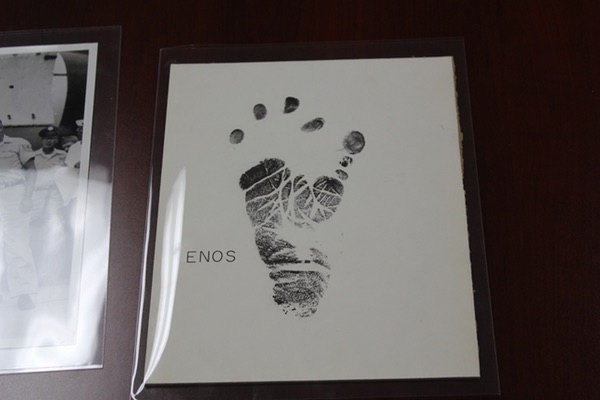 Enos footprint. (credit: D. Day) |
